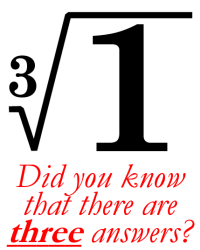 Thinking back on your math classes, you may recall that the square root of a number has two answers, one positive and one negative. For example, the square root of +9 is both +3 and -3 (the first one is known as the principal square root). Squaring +3 gives you +9, of course, but so does squaring -3.
Thinking back on your math classes, you may recall that the square root of a number has two answers, one positive and one negative. For example, the square root of +9 is both +3 and -3 (the first one is known as the principal square root). Squaring +3 gives you +9, of course, but so does squaring -3.
Square roots aren’t the only roots of a number. For example, the (principal) cube root of +8 is +2 because +2³ = +2 × +2 × +2 = +8.
But just as square roots have two answers, cube roots have three (and fourth roots have four and so on and so on).
Which raises the question: What are the other two roots of +8? What number(s), when cubed, gives us +8? I’ll answer that near the end of the post, but to get there we’ll have to back up and lay some groundwork.
It involves getting complex. Specifically, it involves complex (“imaginary”) numbers and the complex plane.
If these are new to you, I recommend my “Imaginary” Numbers, “Imaginary” Parabola, and The Complex Plane posts (or the Wikipedia pages linked in the previous paragraph). From this point on, I’ll assume you’re up to speed on complex numbers and the 2D plane on which they live.
[I’m surprised to find that I’ve never written a post explaining exactly why squaring a negative number (or multiplying any two negative numbers) gives a positive result. I’ll touch on it here, but I should probably write a post focusing on that fact.]
§
We’ll start with a simple example, the square root of +1, which is +1 and -1 (because squaring either of them gives +1; the first one is the principal square root). We’ll also consider a less simple example, the square root of -1, which, perhaps infamously, is the imaginary unit, known as i. In fact, because there are always two square roots, we have both +i and -i. (the first one being the principal square root of -1).
To understand why, we need to understand the complex plane. In particular, the complex unit circle — the circle on that plane with a radius of one.

Figure 1. The complex unit circle.
Figure 1 shows the complex unit circle with black dots at +1, +i, -1, and –i (counterclockwise starting from the right). It also shows (red dot and black arrow) the complex number:
Complex numbers can be expressed in many forms, but each of the above represents the same point on the complex plane. The first one is the real and imaginary (x and y) coordinates as numbers (rounded off to three digits). The second and third use the angle (and implied length of one) of the vector (black arrow), in degrees and radians, respectively.
Complex numbers can also be expressed in a nicely compact exponential form:
Which is convenient for calculations (as you’ll see below). All you really need to know here is Euler’s formula:
Where θ (theta) is the angle measured counterclockwise from “three o’clock” (which, in Figure 1, is 45° or π/4 radians). With this in mind, the four black dots in Figure 1 (+1, +i, -1, and –i) are:
In this case, the four angles are expressed in pi radians, and the key to angles in this form is to remember that a 360° circle is two radians — hence the formula for a circle’s circumference: r2π, where r is the radius (which for the unit circle is just one). This makes a 180° semi-circle one radian.
And note that 180° (or one radian) takes us from +1 counterclockwise to -1, and hence Euler’s Identity:
Which is considered one of the most beautiful equations in math and has been called a sonnet [see Beautiful Math and Circular Math for details].
§
With this background, we have almost everything we need to understand multiple roots. The only other key is that multiplication is rotation. It’s also scaling — making the circle bigger or smaller — but here we’re considering the square and cube roots of one, so all points remain on the unit circle.
That multiplication is rotation isn’t obvious when dealing with the real number line, especially when dealing with positive numbers. That’s because the positive real numbers all have an angle of zero, so multiplying any two positive numbers is zero degrees plus zero degrees. (And remember that in math, we measure angles from the 3 o’clock position.)
The negative numbers have an angle of 180° (or one pi radian), so multiplying by a negative number rotates things 180° to the negative side of the real number line. Multiplying two negative numbers, however, rotates 180° plus 180°, which is why multiplying two negative numbers results in a positive number. (Note that in multiplication as rotation we add the angles of the respective numbers.)
And now we have all the tools needed for square and cube (and greater) roots.
§
We can now return to the square roots of one (which are +1 and -1):

Figure 2. The square roots of unity (a math term for one).
Figure 2 shows the complex unit circle with red dots at +1 and -1. What’s needed for square roots are numbers that, when squared, rotate to +1. Since +1 has an angle of zero (red arrow), +1 times +1 is a rotation of 0° plus 0°.
And since -1 has an angle of 180° (green arrow), -1 times -1 is a rotation of 180° plus 180°, which takes us to +1.
Now we can make sense of the square roots of -1 (which are +i and –i):

Figure 3. The square roots of minus one.
Figure 3 shows the complex unit circle with red dots at +i, -1, and –i. This time, what we need for square roots are numbers that, when squared, rotate to -1, which has an angle of 180° (red arrow).
Since +i has an angle of 90° (green arrow), and 90° plus 90° is 180°, +i is a square root of -1 (the principal square root). And since –i has an angle of 270° (purple arrow), and 270° plus 270° is 540°, this takes us around the circle one-and-a-half times to -1.
One way to see this is that 540° minus 360° is 180°. Another way to see it is that –i is 3/2 pi radians, and 3/2 plus 3/2 is 6/2, which is 2 and 1/2. And remember that two pi radians are a full circle, which we can factor out. It’s worth taking a moment to be sure you understand this because it’s going to come up again.
§
Now we can tackle the cube roots of +1 (and, while we’re at it, -1):

Figure 4. The cube roots of unity.
Figure 4 shows the complex unit circle with red dots at three points around the circle. In fact, then divide the circle into three segments, each 120° apart.
We need three numbers that, when cubed, take us to +1 (the right-hand red dot). As with the square root of one, +1 has an angle of 0°, and 0° plus 0° plus 0° is just 0°. So, +1 is a cube root of +1 — the principal cube root. Also, the real cube root.
The points at 11 o’clock and 7 o’clock are complex roots of +1. The first because 120° plus 120° plus 120° = 360° (or 0°, factoring out the full circle). The second one because 240° plus 240° plus 240° is 720° (or 0°, factoring out two full circles — 360° plus 360° is 720°).
The values of the two complex roots are easy to calculate using the exponential form for complex numbers or the Euler formula cosine/sine version. The first point is 1/3 of a circle, and 1/3 times 2 (pi radians) is 2/3 radians. The second point is 2/3 of a circle, and 2/3 times 2 is 4/3 radians.
Therefore:
We can easily verify the last two by cubing them:
Because the exponent of three cancels out the three in the denominator of the fraction. And:
Because, again, the exponent cancels out the denominator.
In the first case, we go fully around the circle, and in the second case, we go twice around.
We can discover the actual values of the complex roots by using Euler’s formula to get:
Depending on whether we want to work in radians or degrees. Either way, the cosine is -0.5, and the sine is +0.866 (and change). In fact, the latter number is the square root of three divided by two, so the first complex root is:
For the second complex root:
Again, depending on radians or degrees. In this case, the cosine is again -0.5 while the sine is -0.866 (and change), so the second complex root is:
Which is the complex conjugate of the first complex root. The complex cube roots are always conjugates of each other. (A complex conjugate is the same number but with an imaginary part of the opposite sign.) This is readily apparent in Figure 4. A complex conjugate is the same point but “reflected” by the real number (x) axis.
And we have the three cube roots of +1:
Note that the first one is just the complex form of +1.
§
It should now be easy to understand the cube roots of -1:

Figure 5. The cube roots of minus one.
We have essentially the same situation, but rotated by 180° (which makes sense, because -1 is rotated 180° from +1).
The main difference is that, for the real root, we have -1, which has an angle of 180°, and three times 180° is 540°, which factoring out the 360° full circle, is 180°. Or we can think of it as 1π radians times 3, which is 3π radians, and factoring out the 2π, we’re left is one pi radian (or 180° or -1).
The first complex root is just 1/3 pi radian (or 60°), and obviously either multiplying 1/3 by three to get one pi radian or multiplying 60° by three to get 180° gets us to -1.
The second complex root is a little less obvious, but it’s 5/3 pi radians (or 300°), and three times 5/3 is 5 pi radians. Factoring out two full circles (of 4 pi radians) leaves us with one pi radian. Alternately, three times 300° is 900°, and again factoring out two full circles (720°) leaves us with 180°.
The two darker red dots on the circle are to help visualize the rotation. The upper-right red dot rotates first to the upper-left dark red dot and then to the left red dot for -1. The lower-right red dot is almost a full circle minus 1/6th of a circle. Rotating it by the same amount goes almost all the way around but falls short by another 1/6th. Rotating it a second time again falls short by 1/6th, leaving us at the left red dot for -1.
Numerically, in exponential notation, we have:
You can perform the same exercise as above to cube these and, again, the exponent (3) will cancel the denominator of the fraction, leaving 1π and 5π, the latter of which is the same as 1π by factoring out the 4π of two full circles.
We can take the cosine and sine of 60° and 300° to get, for both cosines, +0.5, and for the respective sines, +0.866 and -0.866 (and change). Again, the sine values are the square root of three divided by two, so the cube roots of -1 are:
Comparing Figure 4 and Figure 5, note that the coordinates are the same but reflected on the imaginary (y) axis (alternately, rotated 180°). As before, the two complex roots are complex conjugates.
And there you have it, the cube roots of +1 and -1.
§
Finally, we return to the three cube roots for +8, which is not on the complex unit circle but eight units to the right on the real (x) axis. The real (or principal) root is, as mentioned above +2 (also not on the unit circle). In this case multiplication involves scaling. The real root, +2, has an angle of zero, so no rotation is involved. But we start at +2, scale that by +2 (giving us +4) and scale it again by +2, leaving us with +8.
Our scaling factor is two, so a quick way to determine the first complex cube root is simply to multiply the first complex cube root of +1 by two:
Which is, indeed, the correct answer. The other complex root is just the complex conjugate, so the three cube roots of +8 are:
And now we’re done!
Stay cubed, my friends! Go forth and spread beauty and light.
∇













April 18th, 2024 at 5:58 pm
Once again, I thought this would be a much shorter post. I guess my question is whether there is too much detail (or not enough)?
April 18th, 2024 at 6:00 pm
And perhaps more to the point, these long-ish math-y posts aren’t really living up to the Brain Bubble concept. I really need to retire the category or reserve it for, as originally intended, only short posts (kind of like long-ish tweets).
April 19th, 2024 at 11:26 am
If you’re confused about the part where, when we cube the roots, the exponent, 3, cancels out the denominator, the rule about nested exponents is:
We just multiply them together. So, cubing the first cube root of +1 as an example:
And because we can factor out any multiple of 2π:
Cubing the other roots works in similar fashion.